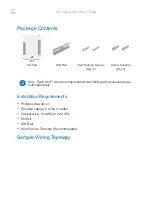
4 Getting Familiar With the controlCARD
4.1 F280025C controlCARD Features
•
F280025C Microcontroller –
High performance C2000 microcontroller is located on the controlCARD.
•
120-pin HSEC8 Edge Card Interface –
Allows for compatibility with all of C2000’s 180-pin controlCARD-
based application kits and controlCARDs. Compatibility with 100-pin controlCARDs can be accomplished
using the TMDSADAP180TO100 adapter card (sold separately).
•
Built-in Isolated JTAG Emulation –
An XDS100v2 emulator provides a convenient interface to Code
Composer Studio
™
without additional hardware. Flipping a switch allows an external JTAG emulator to be
used.
•
Connectivity –
The controlCARD contains connectors that allow the user to experiment with isolated
universal asynchronous receiver/transmitter (UART)/SCI with the F280025C MCU.
•
Key Signal Breakout –
Most GPIO, analog-to-digital converter (ADC) and other key signals routed to hard
gold connector fingers.
•
Robust Power Supply Filtering –
Single 5 V input supply powers an on-card 3.3 V LDO. All MCU inputs are
then decoupled using LC filters near the device.
•
ADC Clamping –
ADC inputs are clamped by protection diodes.
•
Anti-Aliasing Filters –
Noise filters (small RC filters) can be easily added on ADC input pins.
4.2 Assumed Operating Conditions
This kit is assumed to run at standard room conditions. Standard ambient temperature and pressure (SATP) with
moderate-to-low humidity is assumed.
4.3 Using the controlCARD
In order for the controlCARD to operate, the controlCARD’s MCU must be powered. This is most often done
by inputting 5 V through the HSEC connector via an accompanying baseboard. For example, if using a
TMDSHSECDOCK docking station baseboard, 5 V DC should be input into the docking station’s J1 or J17.
Then, S1 needs to be toggled to the appropriate position.
Based on the way the controlCARD is used, additional hardware settings will be necessary (see
).
WARNING
When the controlCARD is used in a high-voltage setup, it is the user’s responsibility to confirm that
the voltages and isolation requirements are identified and understood prior to energizing the board
or simulation. When energized, the controlCARD or components connected to the controlCARD
should not be touched. Furthermore, the capacitor C26:A should be removed to minimize the
possibility of leakage current flowing across the isolation barrier of the controlCARD.
Table 4-1. Emulator Switch Selections
Debug Using CCS and the On-
Card XDS100v2 Emulator
Debug Using CCS and an
External Emulator via the
Baseboard
Standalone (Boot From FLASH
or Other Boot Mode)
S1:A
Position 1: ON (up)
Position 1: OFF (down)
Position 1: OFF (down)
J1:A
Connect a mini USB cable
between J1:A and your computer.
In CCS, use this target
configuration: TMS320F280025C
device with an XDS100v2
emulator.
---
---
S4
Position 1: up- Logic 1
Position 2: down- Logic 0
Putting the C2000 device into
Wait Mode can reduce the risk of
connectivity issues.
Position 1: down- Logic 1 Position
2:up- Logic 0 Putting the C2000
device into Wait Mode can reduce
the risk of connectivity issues.
Set S4 as desired
Baseboard’s JTAG connector
(J2 on Docking Station)
---
Connect an external emulator.
---
Getting Familiar With the controlCARD
SPRUIR3B – SEPTEMBER 2019 – REVISED JUNE 2022
TMS320F280025C controlCARD Information Guide
5
Copyright © 2022 Texas Instruments Incorporated




































